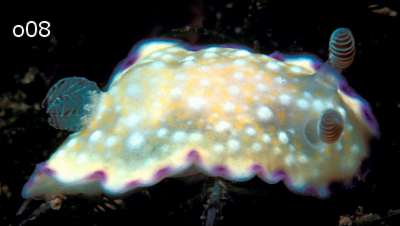
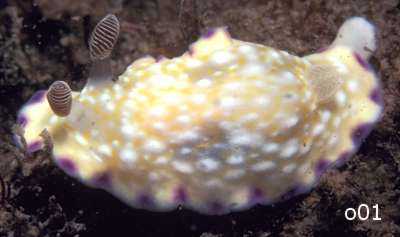
Chromodoris albopustulosa
(Pease, 1860)
Order: NUDIBRANCHIA
Suborder: DORIDINA
Superfamily: EUDORIDOIDEA
Family: Chromodorididae
DISTRIBUTION
This species is known only from Hawaii and the Marshall Ids, but Scott Johnson's messages on the Forum [see #13260] suggest it may be synonymous with C. aureopurpurea, C. alius, and C. rufomaculata, which would give it a wide Indo-West Pacific distribution.
PHOTO
Oahu Island, Hawaii, USA, Pacific. Depth: 2-10 m. Length: 25 mm (o01), 15mm (o08). 1978. Exposed on reef wall. Photographer: Scott Johnson
This is one of a number of white-spotted chromodorids described from Hawaii [see message #13259]. Agreeing in most aspects with the original description [see message #13264], this species has been accepted by recent workers as most likely to represent Pease's Doris albopustulosa.
The mantle is pale yellow with slightly raised opaque white pustules, and the mantle is bordered with either a continuous purple band or broken into a series of purple markings. Scattered on the yellow background colour, between the white pustules, are diffuse, darker yellow spots. The rhinophores stalks are transparent and the clubs are purplish brown with opaque white edging. The gills are arranged in a goblet-shaped cluster and are usually translucent with opaque white edging. The underside is all white.
This species is known only from Hawaii and the Marshall Ids, but Scott Johnson's messages on the Forum [see #13260] suggest it may be synonymous with C. aureopurpurea, C. alius, and C. rufomaculata, which would give it a wide Indo-West Pacific distribution.
-
Bergh, L.S.R. (1881) Malacologische Untersuchungen. In: C.G. Semper, Reisen im Archipel der Philippinen, Wissenschaftliche Resultate. Band 2, Supplement 2., 79-128, Pls.G, H, J-L.
-
Kay, E. A., & Young, D.K. (1969) The Doridacea (Opisthobranchia; Mollusca) of the Hawaiian Islands. Pacific Science, 23(2):172-231.
-
Pease, W.H. (1860) Descriptions of new species of mollusca from the Sandwich Islands. Proceedings of the Zoological Society of London 28: 18-36.
Rudman, W.B., 2005 (March 7) Chromodoris albopustulosa (Pease, 1860). [In] Sea Slug Forum. Australian Museum, Sydney. Available from http://www.seaslugforum.net/find/chroalbopus
Related messages
Chromodoris albopustulosa from Maui
October 5, 2007
From: Philip A. Thomas
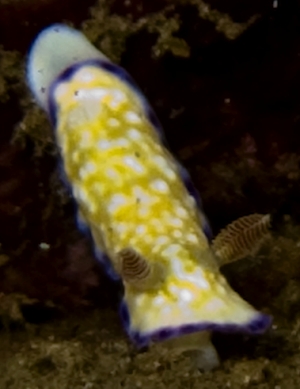
Concerning message #13260:
Locality: Maui, 2-10 feet, Hawaii, USA, Pacific Ocean, 25 September 2007, shallow reef, halfway on some other organism, halfway on sandy, silty bottom. Length: 1 cm
Philip A. Thomas
imagesbypt@philipt.com
Thomas, P. A., 2007 (Oct 5) Chromodoris albopustulosa from Maui. [Message in] Sea Slug Forum. Australian Museum, Sydney. Available from http://www.seaslugforum.net/find/20842Dear Philip,
Thanks for another record of Chromodoris albopustulosa.
Bill Rudman
Rudman, W.B., 2007 (Oct 5). Comment on Chromodoris albopustulosa from Maui by Philip A. Thomas. [Message in] Sea Slug Forum. Australian Museum, Sydney. Available from http://www.seaslugforum.net/find/20842Chromodoris albopustulosa from Kure Atoll
March 7, 2005
From: Scott Johnson
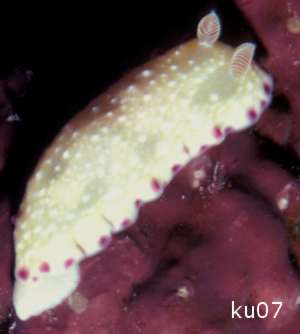
Hi Bill,
Here is another Chromodoris albopustulosa from Hawaii. This one was shot at Kure Atoll, the northwesternmost island of the Hawaiian Archipelago, in June of 1979.
Locality: Kure Atoll, Hawaii, USA, Pacific. Depth: 5-10m. Length: 14 mm. June 1979. In ledges. Photographer: Scott Johnson
Scott
uwkwaj@yahoo.com
Johnson, S., 2005 (Mar 7) Chromodoris albopustulosa from Kure Atoll. [Message in] Sea Slug Forum. Australian Museum, Sydney. Available from http://www.seaslugforum.net/find/13181Thanks Scott,
Best wishes,
Bill Rudman
Chromodoris alius? from Kwajalein, Marshall Islands
March 7, 2005
From: Scott Johnson
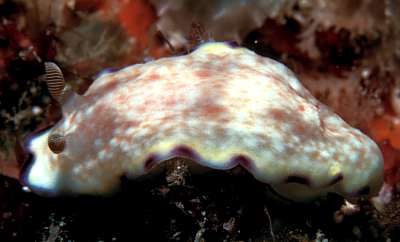
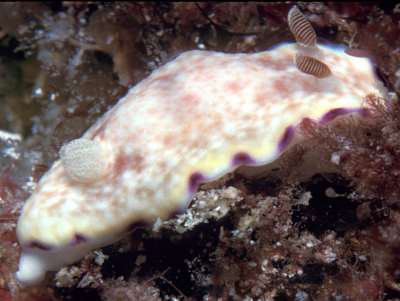
Hi Bill,
Marina Poddubetskaia's recent message [#12900] recording Chromodoris alius from Sri Lanka caused me to dig out my photos of C. rufomaculata from the Marshalls. The attached photos of what I've been lumping with C. rufomaculata appear to match Chromodoris alius. If they do, it would be a fairly long extension of the species' range eastward. The three photos here were all taken at Kwajalein Atoll, Marshall Islands. I have some others from Enewetak Atoll, Marshall Islands, that I will send in a separate message.
I think one feature that threw me off before is that the shape of the gills on these Marshall Islands animals match those of both C. rufomaculata and C. albopustulosa (separate messages) in that they form rather small spherical balls when extended; the specimen from Tanzania on your fact sheet shows the gills much more spread out.
All of these species live in the Marshalls on shallow subtidal lagoon reefs, at depths of about 2 to 10 meters, usually hiding away underneath chunks of sponge encrusted dead coral.
Locality: Kwajalein Atoll, Marshall Islands, Pacific. Depth: 8 m. Length: 20 mm. Under dead coral on subtidal reef. Photographer: Scott Johnson
Scott
uwkwaj@yahoo.com
Johnson, Scott, 2005 (Mar 7) Chromodoris alius? from Kwajalein, Marshall Islands. [Message in] Sea Slug Forum. Australian Museum, Sydney. Available from http://www.seaslugforum.net/find/13185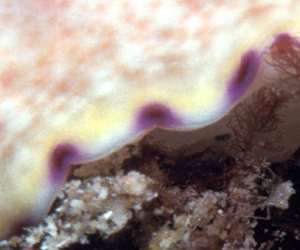
Dear Scott,
Thanks for these photos. As I have said in response to one of your other messages, I think your photos show pretty good evidence to suggest that C. alius, C. rufomaculata, C. albopustulosa and even C. aureopurpurea are all the same species. You mention the way the gills sit in a spherical ball, which I have called a goblet-shape. In the photo of the Tanzanian specimen you mention, it is possible that the animal was oxygen stressed - I can't remember know, but it was photographed in a dish back in my room back at the university so could have been in a dish of unoxygenated sea water for some time. Certainly specimens of Dendrodoris nigra greatly expand their goblet-shaped gill cluster when kept in stagnant sea water. One very convincing point can be seen in the close-up alongside. In C. aureopurpurea, one characteristic feature of the colour pattern are the dark purple spots aroubnd the mantle edge, each surrounded by a paler purple 'halo' and a yellow crescent-shaped cap on the inside edge. In the close-up alongside we only need the yellow band to be broken between each purple yellow spot for this pattern to be just as in C. aureopurpurea.
I have discussed the identify of these species more fully in a separate message [#13260].
Best wishes,
Bill Rudman
Chromodoris alius? from Enewetak, Marshall Islands
March 7, 2005
From: Scott Johnson
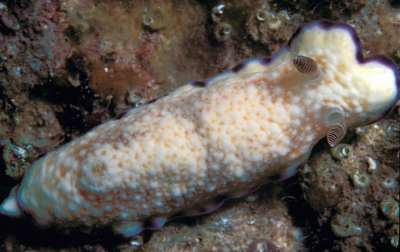
Hi Bill,
To accompany my other message on Chromodoris alius from Kwajalein [#13185], here are photos of a couple more different individuals from Enewetak. These were in the 25-35 mm size range and seem to have a pustulose appearance similar to C. albopustulosa.
Locality: Enewetak Atoll, Marshall Islands, Pacific. Depth: 5-10 m, Length: 25-35 mm. 1983. Under dead coral on subtidal reef. Photographer: Scott Johnson
Scott
uwkwaj@yahoo.com
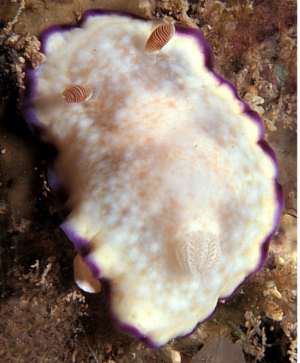
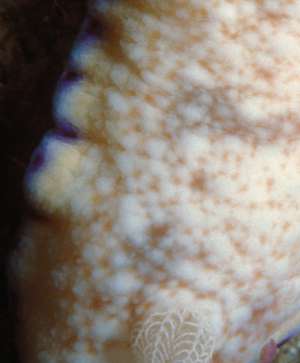
Dear Scott,
Thanks for these. with your other photos, they certainly suggest that C. alius, C. rufomaculata, C. albopustulosa and C. aureopurpureamay be colour forms of a single species. I discuss this more fully in a separate message [#13260]. In this case you can see that the gills can be edged in opaque white, and there are distinct dark pruple spots in the ligher purple border, which is continuous in these animals. They also have a distinct yellowish submarginal band around the mantle edge.
Best wishes,
Bill Rudman
Chromodoris albopustulosa from Hawaii
March 7, 2005
From: Scott Johnson


Hi Bill,
While looking up information to include in my recent messages on Marshall Islands Chromodoris alius, I noticed that a relatively common similar species from Hawaii has not yet made it onto the Forum. Attached are some photos of Chromodoris albopustulosa. Its appearance suggests it is very closely related to C. rufomaculata and C. alius. Neither of these latter two occur in Hawaii, but all three are found in the Marshall Islands (if my IDs are correct). Typical C. albopustulosa differ from those other two species in the presence of white pustulose spots over the dorsum, but these spots do vary and in some specimens are much less distinct. Between the white pustules are orange spots similar to but less distinct than the spots on C. rufomaculata. The rhinophores and gills of particularly C. albopustulosa and C. rufomaculata appear identical; the gills in particular are unusual in that they curl to form quite a round ball shape when extended.
I have found C. albopustulosa at various sites around the islands of Oahu and Hawaii. During the late 1970s, the best site was a dredged channel leading into Honolulu's Ala Wai Yacht Harbor along the edge of a man-made peninsula called Magic Island. Streams from an Oahu valley flow into the Ala Wai canal, which drains to the ocean through this channel. Although not the cleanest looking place to make a dive, the channel walls at the time were richly coated with sponges and other sessile filter feeders, and provided an excellent habitat for quite a few different species of nudis. I haven't been back in quite a few years, but those who have tell me the situation is quite different now. I have also found C. albopustulosa at Kure Atoll at the end of the Hawaiian chain and at Enewetak Atoll in the Marshall Islands.
Locality: Oahu Island, Hawaii, USA, Pacific. Depth: 2-10 m. Length: 25 mm (o01), 15mm (o08). 1978. Exposed on reef wall. Photographer: Scott Johnson
Scott
uwkwaj@yahoo.com
Johnson, S., 2005 (Mar 7) Chromodoris albopustulosa from Hawaii. [Message in] Sea Slug Forum. Australian Museum, Sydney. Available from http://www.seaslugforum.net/find/13187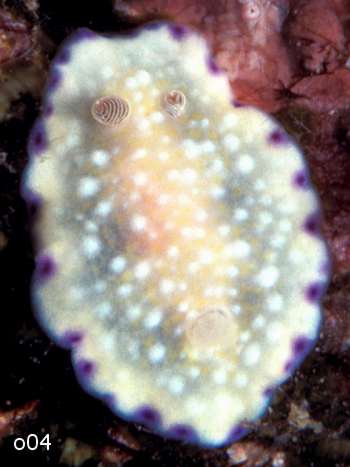
Dear Scott,
Thanks for this and the other messages you have recently sent on these purple and white spotted chromodorids from Hawaii. I agree that your photos suggest a continuum between C. albopustulosa and C. rufomaculata, and your comment [message #13190] suggests they are the same species. Looking at your photo alongside of specimen #o04 makes me wonder whether these two species and C. alius and C. aureopurpurea are just not all colour forms of the one species. The purple patches around the mantle edge have a darker purple spot in the centre, very similar to that in C. aureopurpurea.
I have prepared a Fact Sheet for this species and discussed the synonymy of the 4 species in a separate message [#13260 ]. I have also posted scans of the original illustrations of all the relevant species from Hawaii and the Pacific described by Pease and Garrett.
Best wishes,
Bill Rudman
More Chromodoris albopustulosa from Hawaii
March 7, 2005
From: Scott Johnson
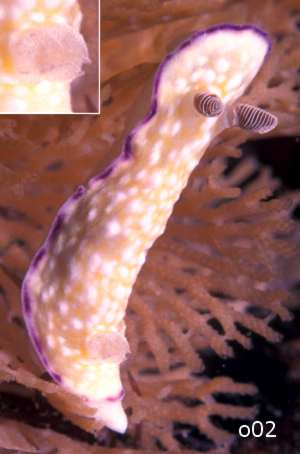
Hi Bill,
Here are a few more Chromodoris albopustulosa from Hawaii. They were photographed at Oahu. One of the specimens was trying to cross a bryozoan colony.
Locality: Oahu Island, Hawaii, USA. Pacific. Depth: 5-10 m. Length: 18mm (o02), 10mm (o05). 1978-9. In ledges. Photographer: Scott Johnson
Scott
uwkwaj@yahoo.com
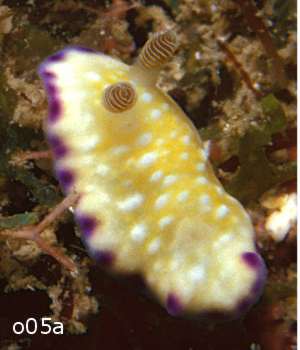
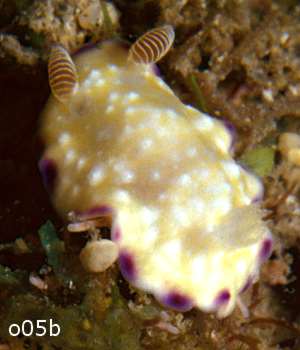
Thanks Scott,
I have included an iset in one of your photos to show traces of the purple color which occurs in the gills of some specimens.
Best wishes,
Bill Rudman
Chromodoris albopustulosa from the Marshall Islands
March 7, 2005
From: Scott Johnson
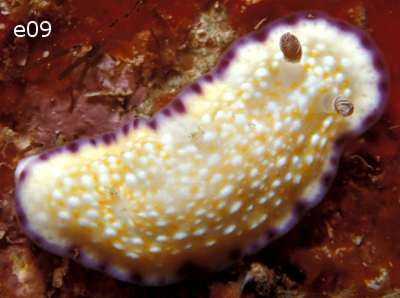
Hi Bill,
To accompany my messages on Chromodoris albopustulosa from Hawaii, here are two C. albopustulosa found at Enewetak, Marshall Islands.
Locality: Enewetak Atoll, Marshall Islands, Pacific. Depth: 5 m. Length: 20 mm (e09), 15 mm (e11). 1982. Under dead coral on subtidal reef. Photographer: Scott Johnson
Scott
uwkwaj@yahoo.com
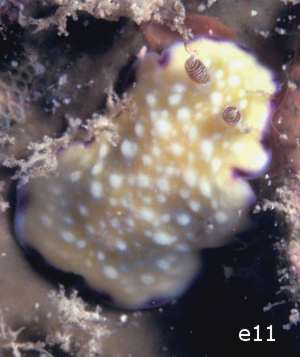
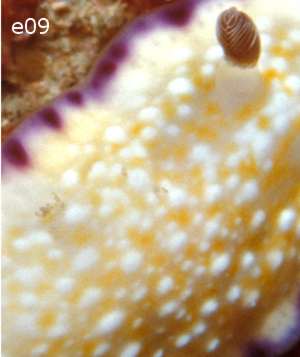
Dear Scott,
Your group of messages are very interesting. In animal e09 the yellow spots are quite diffuse and are surrounded by a translucent brownish patch, remniscent of typical C. alius, and the opaque white spots are on slightly raised pustules. Some of the white pustules coalesce into a larger white background, which is reminiscent of C. rufomaculata. Around the edge, there are purple spots which extend into the white background part of the mantle which is reminiscent of C. aureopurpurea.
As I discuss in a separate message [#13260 ], your photos are pretty good evidence that all these species are colour variants of a single species.
Best wishes,
Bill Rudman
Original illustration of Goniobranchus albomaculatus Pease 1866
March 7, 2005
From: Bill Rudman
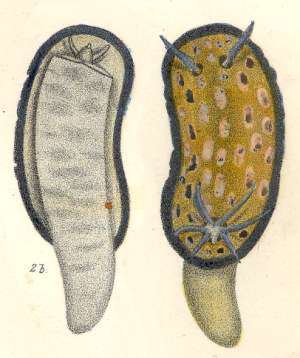
Here is another message concerning the white and purple-spotted chromodorids described from Hawaii by Pease and Garrett. In this one I post the original illustration of Goniobranchus albomaculatus Pease, 1866. The original description did not include an illustration, which appeared in Pease (1871: Plate 20, fig 2 a,b.c.)
The original description included the following colour information:
Colour orange-yellow, margin bright violet, shading off into the ground colour, tubercles whitish, cervical tentacles, branchiae, and under surface cream white. Length 2 inches.
The actual type locality of this species is unknown. It was given as "Pacific Islands". I am not sure which species this is.
-
Pease, W. H. (1866) Remarks on Nudibranchiata inhabiting the Pacific Islands, with descriptions of two new genera. American Journal of Conchology, 2(3): 204-208, pl 14.
-
Pease, W. H. 1871. Descriptions of nudibranchiate Mollusca inhabiting Polynesia. American Journal of Conchology,6(4): 299-305, pls. 19-22.
Bill Rudman
Rudman, W.B., 2005 (Mar 7) Original illustration of Goniobranchus albomaculatus Pease 1866. [Message in] Sea Slug Forum. Australian Museum, Sydney. Available from http://www.seaslugforum.net/find/13232Original illustrations of some Hawaiian chromodorids
March 7, 2005
From: Bill Rudman
To accompany a discussion on Scott Johnson's recent messages [see message #13260] on Chromodoris albopustulosa and similar looking species, I have just posted the original illustrations and relevant parts of the descriptions of the following species. Most are white or yellow spotted species described from Hawaii by Pease. A few are from other Pacific Islands. Many of the paintings are Andrew Garrett's, and some were subsequently published by Rudolph Bergh to illustrate species described unillustrated in Pease's publications.
Doris picta Pease 1860
Doris albopustulosa Pease 1860
Doris propinquata Pease 1860
Goniobranchus albomaculatus Pease 1866
Chromodoris rufomaculata Pease 1871
Doris prismatica var imperialis Pease 1860
Doris vibrata Pease 1860
Many early descriptions give brief features of the external shape and colour, and sometimes a coloured illustration (water colour) of varying quality. Sometimes the original specimens still exist in some museum, but they usually of little value at the species' level, and so we are left with trying to find little clues from the original descriptions.
For example Doris picta Pease, 1860, was identified as Hypselodoris peasei by Kay & Young (1969), but its shape and anatomy, as described by Kay & Young, suggest a species of Glossodoris, and its colour suggests it is Glossodoris rufomarginata. Some species are instantly identifiable from some special character, such as the vibrating gills of Chromodoris vibrata, but a very similarly coloured species with vibrating gills, Doris propinquata, has also been described from Hawaii. Kay & Young (1969) consider it to be a synonym of C. vibrata, but the very large exposed posterior foot suggests it may be Risbecia imperialis, a genus in which the gills often vibrate. One species, Goniobranchus albomaculatus Pease, 1866, has no obvious characters differentiating from many of the other species. Although some of the spots are coloured with purple in the published painting, the original description describes the tubercles as 'whitish'. There seems little point in trying to identify this species.
As I discuss separately [message #13260], although Doris albopustulosa and Chromodoris rufomaculata are identifiable from their original descriptions, it seems they may be colour forms of the same species.
Bill Rudman
Rudman, W.B., 2005 (Mar 7) Original illustrations of some Hawaiian chromodorids. [Message in] Sea Slug Forum. Australian Museum, Sydney. Available from http://www.seaslugforum.net/find/13259White and yellow-spotted Hawaiian chromodorids
March 7, 2005
From: Bill Rudman
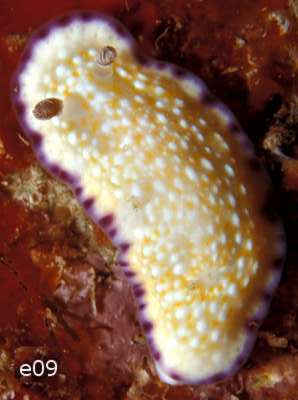
Scott Johnson's recent messages [see below] concerning this white and yellow-spotted group of chromodorids almost certainly suggest that 4 species of Chromodoris, C. aureopurpurea, C. alius, C. rufomaculata and C. albopustulosa are most probably colour forms of one species. This is an interesting example illustrating the problems facing taxonomists when they try to interpret old descriptions and the immense value in studying local faunas and local variation within a species in great detail.
Firstly let's look at the early names, seven of which I have posted copies of the original illustrations [see below]. Many early descriptions give brief features of the external shape and colour, and sometimes a coloured illustration (water colour) of varying quality. Sometimes the original specimens still exist in some museum, but they usually of little value at the species' level, and so we are left with trying to find little clues from the original descriptions. I have discussed some examples in a separate message [#13259 ].
If we look at C. albopustulosa [upper right] we see a form with a pale yellow background, darker yellow spots, and raised white pustules and a border with a pale purple band and spaced dark pueple spots. But from Scott Johnson's photos, this species can have a uniform yellow background, and the purple border can be broken into separate purple patches, each with a pale purple background and an intense purple spot. The photo of Chromodoris rufomaculata [lower right] shows a form in which yellow spots predominate on a mottled white background. However as Scott Johnson's photos show there is a continuum between this and typical C. albopustulosa, the white background in C. rufomaculata occurring when the white pustules of C. albopustulosa expand to replace the pale yellow background. In this species as well the purple margin is variable, sometimes entire sometimes broken. In both species the thinophore clubs are dark brown or purple with white edging, and the gills, which are held in a goblet shaped cluster, have opaque white edging. Scott Johnson reports these two 'species' mating in captivity [message #13190]. If we look at C. aureopurpurea [lower left] we see close similarities, and if we look at the variations in colour pattern reported for that species in the Forum we see a very similar continuum. Of particular interest are the purple spots around the mantle edge which in C. aureopurpurea are characterised by a dark purple spot on a lighter purple background and a yellow crescent shaped band at the inside edge. Many 'forms' of C. rufomaculata and C. albopustulosa have a yellow submarginal band just on the inside of their purple border which is almost certainly homologous to this yellow crescent. I proposed Chromodoris alius as an Indian Ocean species related to these other species. Scott Johnson's photos from the Marshall Ids would suggest that this is a form of C. albopustulosa in which the darker yellow spots are absent.
All forms have thinophore clubs which are dark brown or purple with white edging, and gills, which are held in a goblet shaped cluster, have opaque white edging. From my earlier work with this group, and Kay & Young's published descriptions, I can find no major anatomical differences between the species. Although I very much doubt it, it is still possible that one or more of these 'species' may be a very close mimic. What we clearly need to do is to build up more information on their biology, what their egg ribbons look like and what sponges do they feed on.
In the meantime I will add a note to the four Fact Sheets suggesting they may be all the same species
Best wishes,
Bill Rudman
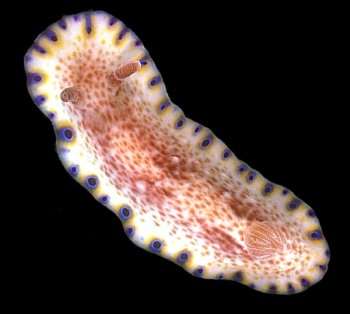
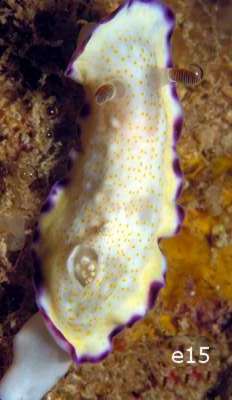
Here are links to the relevant messages.
Original illustrations of:
Doris picta Pease 1860
Doris albopustulosa Pease 1860
Doris propinquata Pease 1860
Goniobranchus albomaculatus Pease 1866
Chromodoris rufomaculata Pease 1871
Doris prismatica var imperialis Pease 1860
Doris vibrata Pease 1860
Scott Johnson messages:
Chromodoris rufomaculata from the Marshall Islands
Chromodoris albopustulosa from the Marshall Islands
More Chromodoris albopustulosa from Hawaii
Chromodoris albopustulosa from Hawaii
Chromodoris alius? from Enewetak, Marshall Islands
Chromodoris alius? from Kwajalein, Marshall Islands
Chromodoris albopustulosa from Kure Atoll
References:
-
Kay, E. A., & Young, D.K. 1969. The Doridacea (Opisthobranchia; Mollusca) of the Hawaiian Islands. Pacific Science, 23(2):172-231.
-
Rudman, W. B. 1990a. The Chromodorididae (Opisthobranchia: Mollusca) of the Indo-West Pacific: further species of Glossodoris, Thorunna, and the Chromodoris aureomarginata colour group. Zoological Journal of the Linnean Society, 100(3): 263-326.
Original illustration of Doris albopustulosa Pease 1860
March 7, 2005
From: Bill Rudman
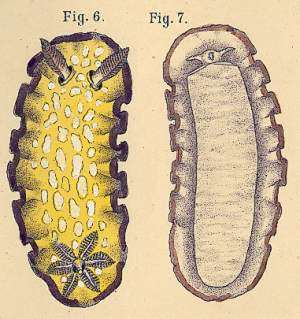
Here is another message concerning the white and purple-spotted chromodorids described from Hawaii by Pease and Garrett. In this one I post the original illustration of Doris albopustulosa, Pease, 1860
Doris albopustulosa was originally described (Pease, 1860) without an illustration. Bergh (1881: Pl. G, fig 6-7) subsequently published a painting by Andrew Garrett, which we assume was available to Pease. He called it Chromodoris albopustulosa.
Here is Pease's description of the external colour:
Colour above lemon yellow, pustules white, and the margins of the mantle edged with purple. Dorsal tentacles reddish-brown, with white lamellae. Branchiae white. Foot and beneath mantle white. Length 1 inch.
-
Pease, W.H. (1860) Descriptions of new species of mollusca from the Sandwich Islands. Proceedings of the Zoological Society of London 28: 18-36.
-
Bergh, L.S.R. (1881) Malacologische Untersuchungen. In: C.G. Semper, Reisen im Archipel der Philippinen, Wissenschaftliche Resultate. Band 2, Supplement 2., 79-128, Pls.G, H, J-L.
Bill Rudman
Rudman, W.B., 2005 (Mar 7) Original illustration of Doris albopustulosa Pease 1860. [Message in] Sea Slug Forum. Australian Museum, Sydney. Available from http://www.seaslugforum.net/find/13264